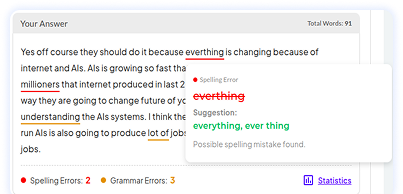Duolingo exam is considered a convenient English language test among students. Its adaptive format and convenience have led to widespread acceptance by over 5,000 universities globally. To excel in this hour-long exam, which evaluates reading, writing, listening, and speaking skills, comprehensive practice of each question type is essential. Out of multiple question types, fill-in-the-blanks is a bit tough. So, to help you with that, here are Duolingo fill in the blanks practice tips and tricks.
Understanding the Format
- Short time limit: Typically around 20 seconds per question.
- Focus on vocabulary and grammar: You must choose the correct word to complete the sentence.
- Scoring: Based on accuracy and speed.
How to Improve Fill in the blanks in Duolingo English Test
Expand Your Vocabulary:
- Building a strong vocabulary is essential for excelling in fill-in-the-blanks. Immerse yourself in the language by reading books, articles, and online content. Utilize flashcards, vocabulary lists, and spaced repetition systems to memorize new words effectively.
- Additionally, explore different learning techniques that resonate with you. Visual learners might benefit from creating mind maps or images associated with new words, while auditory learners could create mnemonic devices or rhymes.
Master Grammar:
- Develop a keen sense of parts of speech: Practice identifying nouns, verbs, adjectives, adverbs, and other word classes within sentences. This knowledge will help you recognize the grammatical role of each word and the types of words that can fill in the blanks.
- Master verb tenses: Familiarize yourself with different verb tenses and their usage in various contexts. Understanding how to conjugate verbs correctly is essential for constructing grammatically sound sentences.
- Analyze sentence structure: Break down sentences into constituent parts to understand how words and phrases relate. This will enable you to identify the grammatical relationships between words and determine the word choice for the blanks.
Read Regularly:
- Reading is a cornerstone of language learning, offering numerous benefits for improving your fill-in-the-blanks in Duolingo exams. Immersing yourself in diverse texts will expand your vocabulary, introduce you to a wide range of sentence structures, and help you develop a deeper understanding of how words are used in context.
- Select reading materials that align with your interests and language level to make learning enjoyable and effective. Pay close attention to the author’s word choice, sentence structure, and overall style. Analyze how different words and phrases contribute to the meaning and tone of the text.
Practice Consistently and Effectively
Time Management:
- Develop a sense of urgency during practice sessions.
- Train yourself to process information and make decisions under time pressure quickly.
- Learn to allocate time efficiently, focusing on the most challenging blanks first.
- Practice with a timer to simulate the test conditions and improve your speed.
Practice Strategies:
- Dedicate specific time slots for focused fill-in-the-blank practice. Regularity is key to building muscle memory and improving your speed and accuracy.
- Create exercises using articles, news pieces, or favorite books. This personalized approach lets you target specific challenging vocabulary or grammar areas.
- Learn from Mistakes. Analyze incorrect answers to identify knowledge gaps and misconceptions. Understanding why an answer is wrong will help you avoid repeating the same mistakes in the future.
- Track Your Progress to monitor your performance over time and identify areas for improvement. This data-driven approach will help you stay motivated and focused.
Contextual Understanding:
- Analyze the sentence structure carefully to understand the missing word’s grammatical role and the required word type. Consider the parts of speech involved and how they interact with each other. This analysis will help you narrow the options and select the word that fits grammatically and semantically.
- Examine the surrounding context to gain insights into the meaning and intended relationship between the ideas. Look for clues in the preceding and following sentences that provide additional information about the missing word. Consider the overall tone and purpose of the text to ensure that your chosen word aligns with the intended message.
- By carefully analyzing the sentence structure and surrounding context, you can better understand the missing word’s function and select the most appropriate option. This comprehensive approach will enhance your accuracy and overall performance in fill-in-the-blank exercises.
Eliminate Options Strategically:
- When faced with multiple-choice options, employ a strategic approach to eliminate incorrect answers efficiently. Start by identifying any grammatically incorrect options or semantically incompatible with the sentence. Eliminate these options outright to narrow down your choices.
- Next, consider the context of the sentence and the surrounding words. Look for clues that suggest the appropriate part of speech or word form for the blank. This will help you eliminate options that don’t fit the grammatical requirements of the sentence.
- Once you’ve eliminated some options, carefully evaluate the remaining choices. Consider the nuances of meaning and how each option would affect the sentence’s overall meaning. Try substituting each option into the blank and assessing how it sounds and fits within the context.
Learn from Mistakes:
- Thoroughly analyze your incorrect answers to pinpoint your knowledge gaps. Understanding why the correct answer is correct and how it differs from your chosen option is crucial for learning from your mistakes. This self-reflection will deepen your understanding of the language and prevent you from repeating the same errors in the future.
- Identify the specific areas where you made mistakes. These could be related to vocabulary, grammar, or understanding the context. You can focus your practice efforts and enhance your overall performance by pinpointing the areas that need improvement.
- Review the correct answers and explanations. Understanding the reasoning behind the correct choices will broaden your knowledge and help you develop a deeper understanding of the language. This will enable you to apply your knowledge to future exercises and challenges.
You can also practice with Gurully. We provide full-length mock tests with real-time exam simulation. Our AI scorning will give you instant results to see where you are lacking. You can customize the practice package to your convenience. The mock test is curated by experts so that students can practice authentic content.
Start your free DET mock test with Gurully and get AI-powered analysis for a personalized journey.


- Kickstart your DET prep with a free AI-scored mock test
- Boost your score with in-depth analysis & smart recommendations
Duolingo English Test Fill in the Blanks Practice Questions with Answers
Level 1 (Beginner)
- Scientists strive to unde_ _ _ _ _ _ how the world works to help improve everyone’s lives.
Answer: Understand - After several attempts to reach him, I fin_ _ _ _ got a call from Jamar.
Answer: Finally - Did you find any evi_ _ _ _ _ to support your theory?
Answer: Evidence - The we_ _ _ _ forecast predicts heavy rain tomorrow.
Answer: weather - He is very pol_ _ _ when speaking with elders.
Answer: polite - The train will arr_ _ _ at the station in ten minutes.
Answer: arrive - We need to res_ _ _ _ the meeting for next week.
Answer: reschedule - The book’s sto_ _ _ _ _ was fascinating and full of mystery.
Answer: storyline - The chil_ _ _ _ _ were excited about their upcoming trip to the zoo.
Answer: Children - Please fo_ _ _ _ the instructions carefully to complete the task.
Answer: follow
Level 2 (Intermediate)
- The rocket’s traj_ _ _ _ _ _ indicated it would land far off the intended mark.
Answer: trajectory - I managed to bar_ _ _ _ with the shop owner to bring the price of the used laptop down to half.
Answer: bargain - In examining the financial records, irregularities were found, suggesting frau_ _ _ _ _ _ activities.
Answer: fraudulent - The con_ _ _ _ _ of the speech was relevant to current global issues.
Answer: content - The decision was con_ _ _ _ _ _ by the committee after careful deliberation.
Answer: confirmed - He possesses a nat_ _ _ _ ability to learn new languages quickly.
Answer: natural - The company’s rapid expa_ _ _ _ _ _ led to increased revenue.
Answer: expansion - Due to heavy rains, the river’s wa_ _ _ level rose significantly.
Answer: water - The inves_ _ _ _ _ _ conducted detailed research before making a decision.
Answer: investor - The patient’s symptoms were diag_ _ _ _ _ _ as a viral infection.
Answer: diagnosed
Level 3 (Advanced)
- Over the years, as I’ve developed other hobbies, I’ve noticed my interest in video games dwi_ _ _ _ significantly.
Answer: dwindle - The ard_ _ _ _ climb to the top of the mountain left her feeling exhausted and exhilarated at the end.
Answer: arduous - The chameleon, a master of adaptation, can camo_ _ _ _ _ _ itself to blend perfectly with its surroundings.
Answer: camouflage - The man’s ecc_ _ _ _ _ _ _ behavior made him stand out in the crowd.
Answer: eccentric - The scientist’s hypo_ _ _ _ _ _ was later proven correct through experimentation.
Answer: hypothesis - The deep-rooted ani_ _ _ _ _ _ _ between the rival groups persisted for years.
Answer: animosity - The lawyer made a comp_ _ _ _ _ _ _ argument that swayed the jury’s decision.
Answer: Compelling - The vast emp_ _ _ _ _ _ _ stretching across the desert seemed endless.
Answer: emptiness - His ability to enu_ _ _ _ _ _ each word clearly made his speech powerful.
Answer: enunciate - The artist’s new painting was a mesm_ _ _ _ _ _ _ masterpiece admired by all.
Answer: mesmerizing
Conclusion:
The Duolingo English Test has emerged as a popular choice among students. While the test evaluates reading, writing, listening, and speaking skills, the fill-in-the-blank section can be challenging. To excel in this format, focus on expanding vocabulary, mastering grammar, and consistent practice. You can effectively do Duolingo fill in the blanks practice by managing time, analyzing sentence structure, and learning from mistakes. Students can significantly improve their performance in the Duolingo English Test.
Essentially, the key to success in the Duolingo fill in the blank practice lies in language proficiency, strategic test-taking skills, and consistency.
FAQ:
How to do fill in the blanks in Duolingo?
How to get 120 in Duolingo?
Is getting 100 in Duolingo easy?
How to find fill in the blanks answers?
Is Duolingo harder than IELTS?
- Duolingo Read and Complete Question Tips and Tricks To Score High
- Your Guide to Duolingo English Test Fee – 2025
- Top Duolingo Accepted Universities in USA, UK, and Canada for 2025





